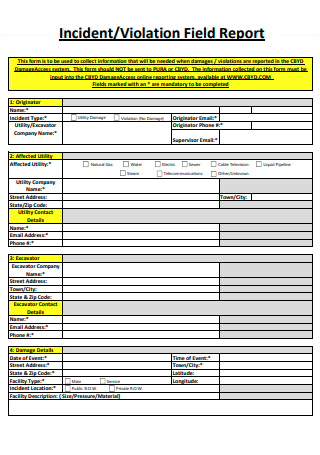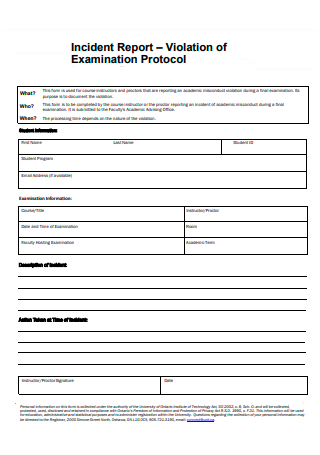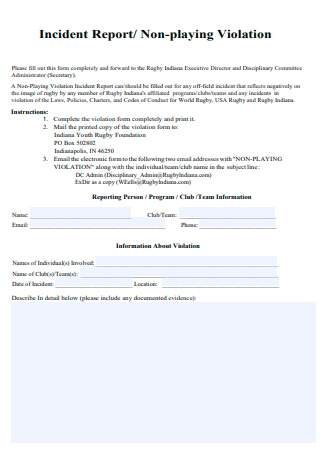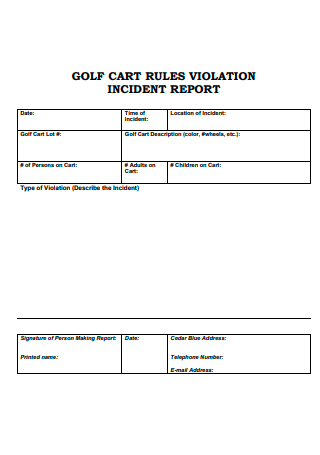3+ Sample Incident Violation Report
FREE Incident Violation Report s to Download
3+ Sample Incident Violation Report
What Is an Incident Violation Report?
Various Types of Incident Reports
Different Incidents to Report
How to Write an Incident Violation Report
FAQs
What requires an incident report?
What is an unusual incident report?
What is an example of a workplace incident?
What Is an Incident Violation Report?
An incident violation report is a document in which safety experts, such as a supervisor, detail an occurrence that may or may not have caused a violation and resulted in injury to an individual, corporate property, or equipment. Whether a near miss or a sentinel incident, such occurrences must be documented to reinforce your safety strategy and reduce injuries and illnesses. Consider these reports as a tool to help you identify opportunities to enhance your safety plans and programs, making your workplace a safer place to work.
Various Types of Incident Reports
Dealing with an employee incident is not unavoidable but it can be lessened. This incident violation report sample is a manner that should be incorporated into each company. But before delving into the process, first, read this curated list to discern which type is for you. There are several sorts of occurrences that you might report while on the job. Keep in mind that these accidents should be reported as soon as they happen to effectively manage risks and safeguard personnel.
Different Incidents to Report
As minor as miscellaneous incidents can be, they still require precise action taken to address the root cause. Not only would this determine what has been causing it to affect the flow of the workplace, but it also helps to prevent or end it from reoccurring. The items listed below present you with various cases that can warrant submitting an incident violation report. Read each point carefully because you may have missed one crucial detail.
How to Write an Incident Violation Report
There may come a time when you will have to be tasked with writing and submitting an incident violation report. Don’t freeze and be pressured into constructing each section because this article has prepared a guide for you to go along with so you don’t merely produce blank incident reports. With that being said, you have gathered all the preliminary information before writing the report itself and are now ready to go into the actual process of formulating the report.
1. Take Immediate Action
Employees in your firm should immediately alert their manager or another member of the company’s leadership committee whenever an incident happens, regardless of its kind whether it be an accident, illness, injury, or near miss. That being stated, communication routes must be clearly specified to foster the practice of employees coming forward in these instances and the value of doing so. If the hazard remains, the management to whom the occurrence was reported must eliminate it by controlling it. Based on the nature of their business, each organization should have a set method for doing this.
2. Collect the Facts
Once the immediate action has been completed, which includes responding to the event and removing the hazard from the environment, it is time to establish and document the facts relating to the incident specifics. Determine the exact place, time, and date of occurrence. This information is critical to the inquiry and the most evident to gather. Gather information on people who were involved in and affected by the incident. This would require documenting the identities of the persons concerned, their job descriptions, the departments in which they work, and the managers of those impacted. Other information to include in this section is the witnesses, the context or situation, actions taken, the environment, the injuries sustained, immediate treatment is given, and the damages.
3. Analyze and Reflect
Collecting and documenting the circumstances surrounding the incident’s occurrence will assist in establishing how the incident occurred. Analyzing the incident’s gathered details will assist in establishing why the incident occurred. Analyzing the event and establishing how and why it occurred is critical for developing an effective corrective action plan. For this part, you may need a team or consultation from experts who have more experience with addressing the incident. At the same time, reaching out to said professionals would help in determining what is the best method to do regarding the continuous issues faced by your company.
4. Establish a Corrective Action Plan
An incident corrective action plan would include suggestions to lessen the risk of a recurring problem and/or reoccurrence of the incident specifics. It should include occupational health and safety training for employees, preventative routine maintenance processes to ensure equipment is in proper working order, a review of job procedures and practices with a recommendation for changes to reduce the risk of incidents, conducting a work hazard analysis to determine if other potential hazards are associated with the task and environment, and then training employees on these hazards based on the findings of the assessment method. Incorporating that in your incident violation report letter would help with concretizing the items listed in the plans.
FAQs
What requires an incident report?
When an unexpected occurrence happens, an incident report should be filed. An incident report is necessary if a patient complains, a prescription error happens, a piece of medical equipment fails, or anybody, regardless of whether they are a client, patient, staff member, or visitor, has experienced an injury or was engaged in a scenario with the potential for damage. Consider the aims of incident reports before objecting to the necessity to file one for a seemingly insignificant event. This can be taken into account when checking the incident reporting examples.
What is an unusual incident report?
An uncommon incident, also known as a UI, is a person-related event or occurrence that is not consistent with ordinary operations, rules, and procedures, or the person’s care or treatment plan, but is not a major unusual incident. Unusual Incidents are defined as incidents involving serious illness or accidents, an individual’s death, an individual’s injury or illness requiring inpatient or emergency hospitalization, attempted suicides, a fire needing the services of a fire department, an act of violent behavior, or any incident requiring abuse. Such incidents, though unusual, are still necessary to be written into a report to facilitate the effects on involved individuals and affected employees.
What is an example of a workplace incident?
Serious workplace accidents, illnesses, and harmful situations must be reported to your local authority’s health and safety department. They must report situations involving death, significant injuries, such as a broken arm or ribs, dangerous accidents such as scaffolding falls, persons overpowered by gas, or any other injury that prevents an employee from performing their usual work for more than three days, and contagious illness. Your employer is responsible for reporting, but if you are engaged, you should ensure that a report has been done and submitted.
Incident violation reports are more helpful than they appear. Even if you or other departments within your organization and company think little of an incident, it may affect others on a different scale. This, in return, does affect productivity since it can disturb them and plague them. This goes without saying that producing a compliance incident report does require time to compose its contents, but has its own sets of benefits that go with it. They aid in safety, protection, sustainability, and quality assurance, as well as the identification of areas where more assistance is necessary to ensure that no catastrophic events occur. The reports’ frequency also allows for quantitative analysis which can help in the data composition of your company.




